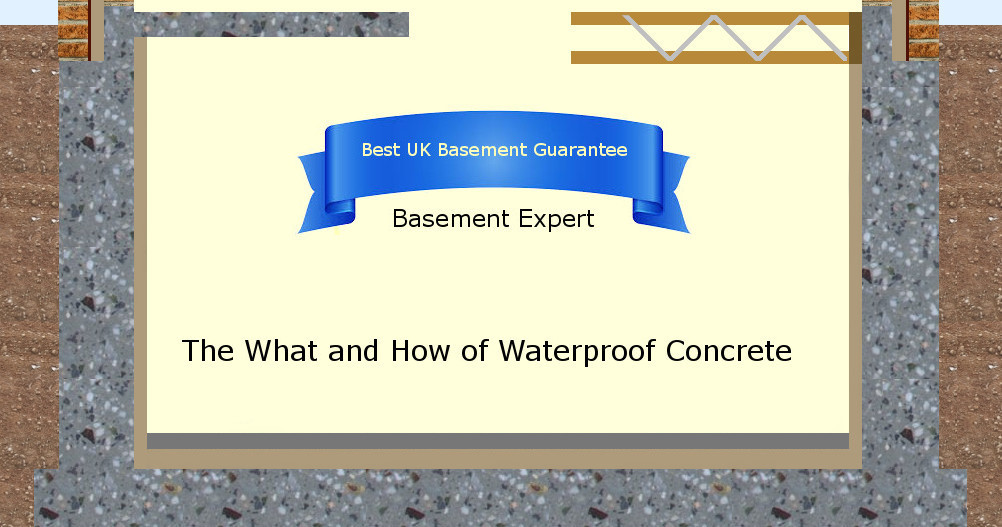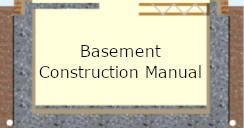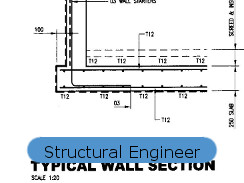| |
Where to buy from, how to pump, and the ideal team for your waterproof concrete.
If you want information on ORDERING waterproof concrete, How to order waterproof concrete page.
This page is sharing my knowledge, experience, and opinions, with an eye on your success.
Otherwise known as, how to have a successful day without everyone shouting at each other. And no ingress of water later.
The pitfalls involve volumetric trucks and most of the suppliers of readymix concrete in drum trucks, as well as experienced labour. In other words, almost everyone could fail you.
Most concrete is made either by
-
Volumetric trucks that cheat you on quantity and quality, or
-
Batching plants that fill trucks with rotating drums on the back .....
-
that have dumbed-down and cut costs (particularly on batching plant operating staff with any intelligence).
-
struggle to deliver before the concrete begins to harden due to increased congestion on the roads.
-
And, with extra water added by the driver or the labourers.
|
|
|
This is an extract from page 5 of an academic paper, Modern Cements, published by the UK's Mineral Products Association. You can open the full document supplied to me here
Importance of workmanship
There really is no substitute for good practice and workmanship in ensuring a durable cement-based building product. It is essential to use the correct materials, proportion and mix the materials properly, add the correct amount of water, compact, cure and protect as appropriate. When using low carbon, factory-made composite cements (CEM II etc), it is particularly important to ensure that effective curing (days rather than hours) is applied. Precautions should be taken to avoid loss of water to the surroundings and to prevent premature drying whether the end-use is: concrete, mortar, screed or render.
|
|
I am telling you, that if you leave waterproof concrete up to those I list above the statement, each of them are likely to fail the statement in multiple ways.
You need to remove them all from your supply chain, if waterproof concrete is your aim.
Most aggregate used in concrete and most cement production is owned by foreign-owned firms that make cement abroad. Making concrete sells their minerals, and that is their primary concern. They no longer seem concerned with customer satisfaction.
Added to which is falling sales. This could lead to more batching plants closing, and even longer journey times for trucks - and more concrete out of time before it is placed and compacted. Article here.
The only completely reliable supplier of waterproof concrete today, as far as I have found, is Mixamate who, unfortunately, are not everywhere. Their depots in the south east are in Edmonton, West Drayton, Worthing and Fareham.
1. Mixamate.
Accurate high quality concrete made at site and pumped immediately giving the client two hours working time from when water was added to the mix just moments earlier.
Volumetric mixers can give you the same working time but nothing like the same quality, and definitely not waterproof concrete.
Drum trucks can often give the same quality concrete, but too frequently don't. They cannot give you two hours working time because their journey eats into that time. The M25 has delays every day of the year. Driving through much of London is limited by the 20mph speed limit and queues at hundreds of sets of traffic lights. A truck can easily take over an hour to get to you leaving you insufficient time to discharge the load, get it level, vibrated and finished before it is going hard.
As the Mixamate batch is made you can see everything going on on the screen. The water is recorded.
They add my powder that I measured out for them when they add water. If the stone/sand mix is dry they will add more water than the recipe. If it is wet they will reduce the water.
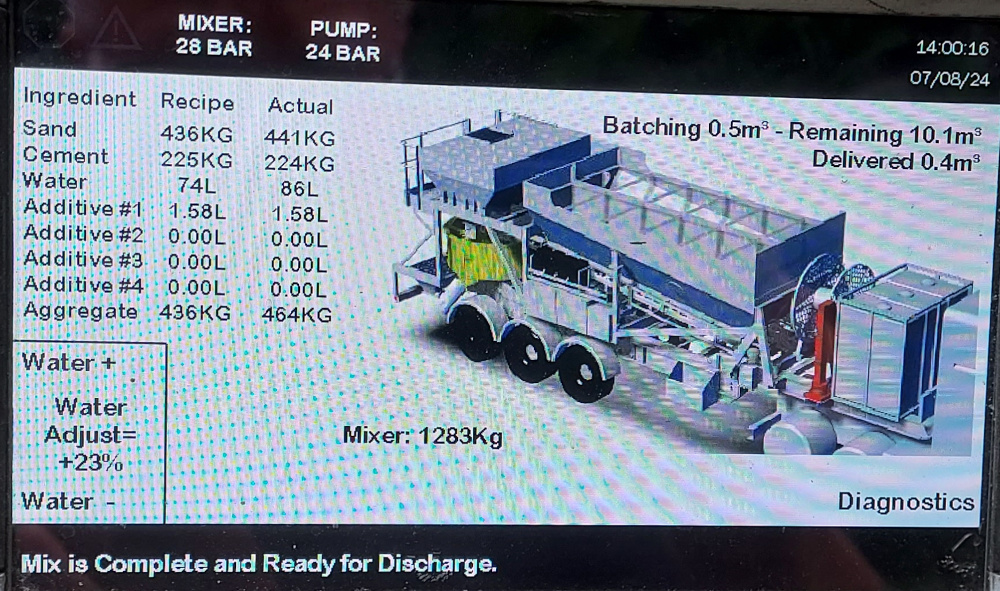
When everything is ready the concrete is discharged and pumped.
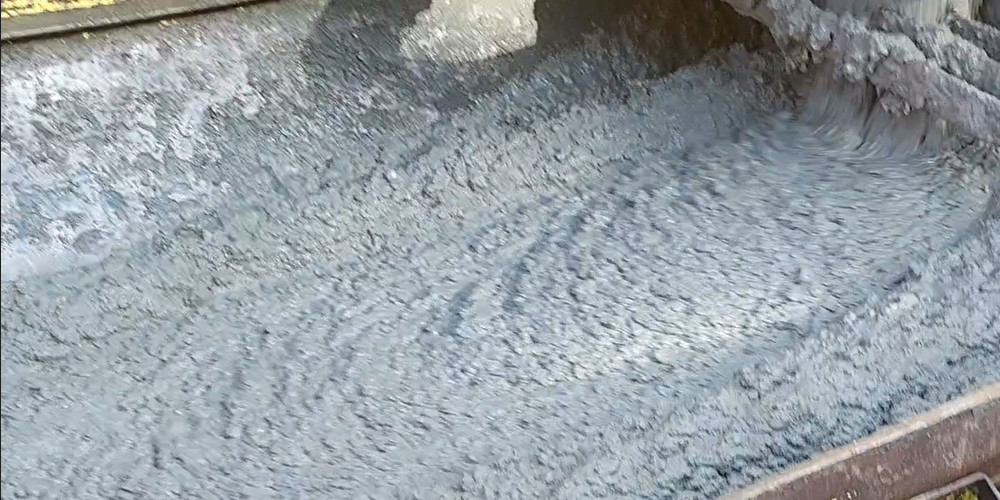
Mixamate's video of the Mixamate pump truck. The 3" pipe is easily moved around - even full of concrete.
Mixamate's video pumping concrete at my Sevenoaks client. Just a husband and wife poured nearly 40m³ in one day.
Mixamate video on TikTok pouring the slab at my client in Epsom.
Mixamate Instagram video briefly interviewing me at my Epsom Client after we finished filling the walls.
Mixamate make their own trucks near Sheffield. They have adapted and improved them over many, many years. They make different trucks with different specialities.
The computer won't let the driver continue unless an ingredient is added at the correct weight. It tells the driver when it has been mixed thoroughly.
Amongst the fleet are 28 trucks that weigh batch concrete and pump it through a 3" diameter flexible hose. These trucks carry 65m of flexible hose. The extra charge for this truck that pumps is £400 plus VAT.
The man is there for you to talk to, not pretending he cannot hear you on the end of a phone or just sending a message to another department so nothing happens.
|
|
My Maldon clients told me something of the problems they had with drum trucks and volumetric trucks.
Hanson had been very awkward. They had poor supply but all their complaints were denied. So they organised friends to follow trucks and they filmed trucks stopping in laybys to add water. Hanson gave in on some of the complaints and paid them £10,000 to settle out of court. But it took a lot of work to get it.
As well as poor quality, a volumetric truck drove into a ditch. The clients had to spend much of the day emptying it of all its aggregate before a rescue vehicle could drag it out. But the supplier refused to give them anything for their time or machinery.
|
|
On this, the first occasion I used Mixamate, the aggregates were dry due to the weather. After the first mix was complete, I was invited to add more water as I wished. There needs to be just enough for my powerful plasticiser to make the big difference it makes. We noted the extra water and set the water-adjust to do the same from then on.
Mixamate buys aggregate premixed. Ballast and concreting sand (which is like sharp sand but more evenly graded). It gets delivered to its yards. Throughout the day, all their trucks are visiting the most convenient yard to top up depending on where they go next.
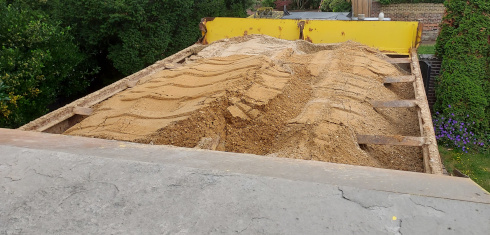
|
|
This is the detailed control panel. Mix design 33 selected.
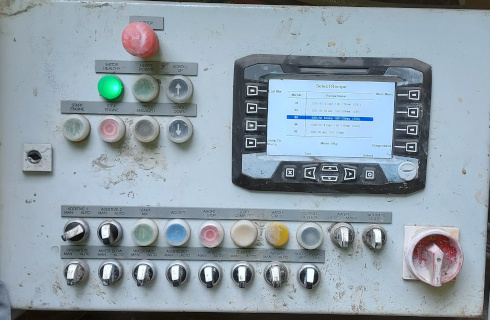
|
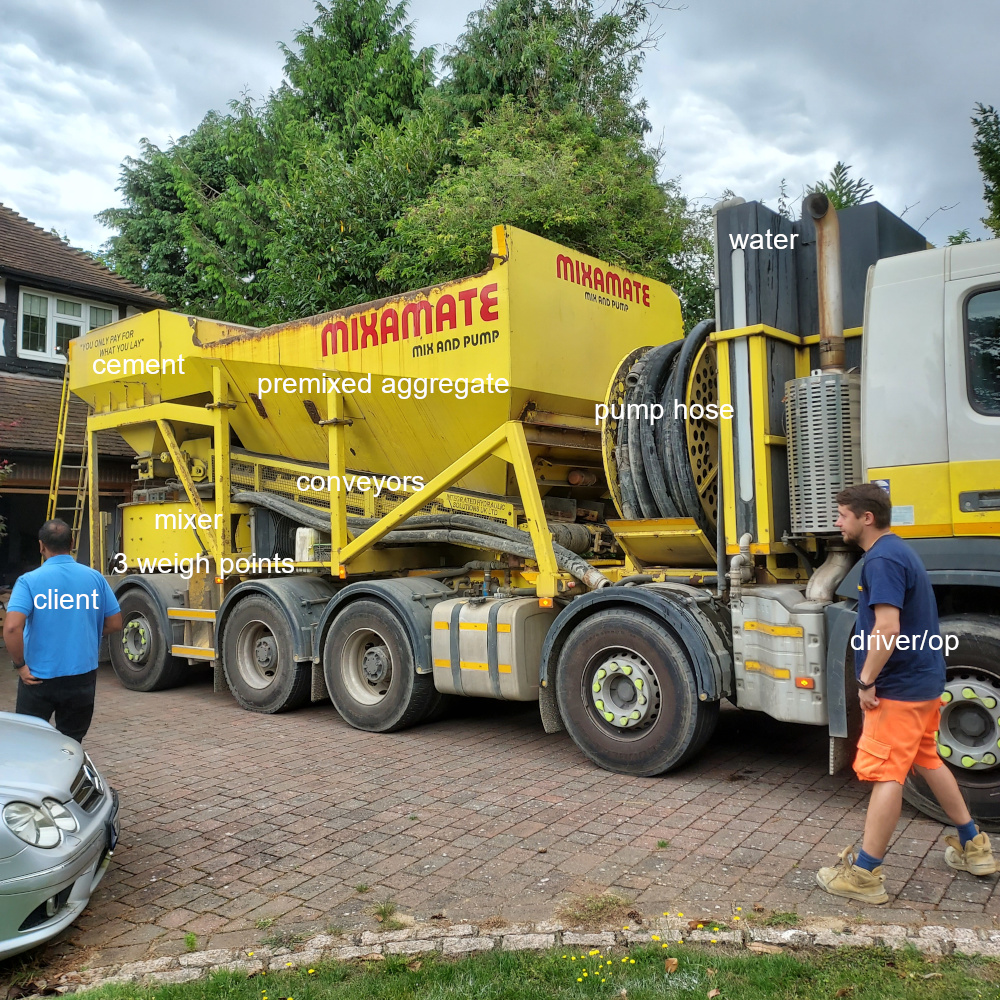
2. Your best concrete pumping choices. And pump costs v labour costs.
I have a basic introduction to pumps page here.
This is the same Mixamate truck from the other corner.
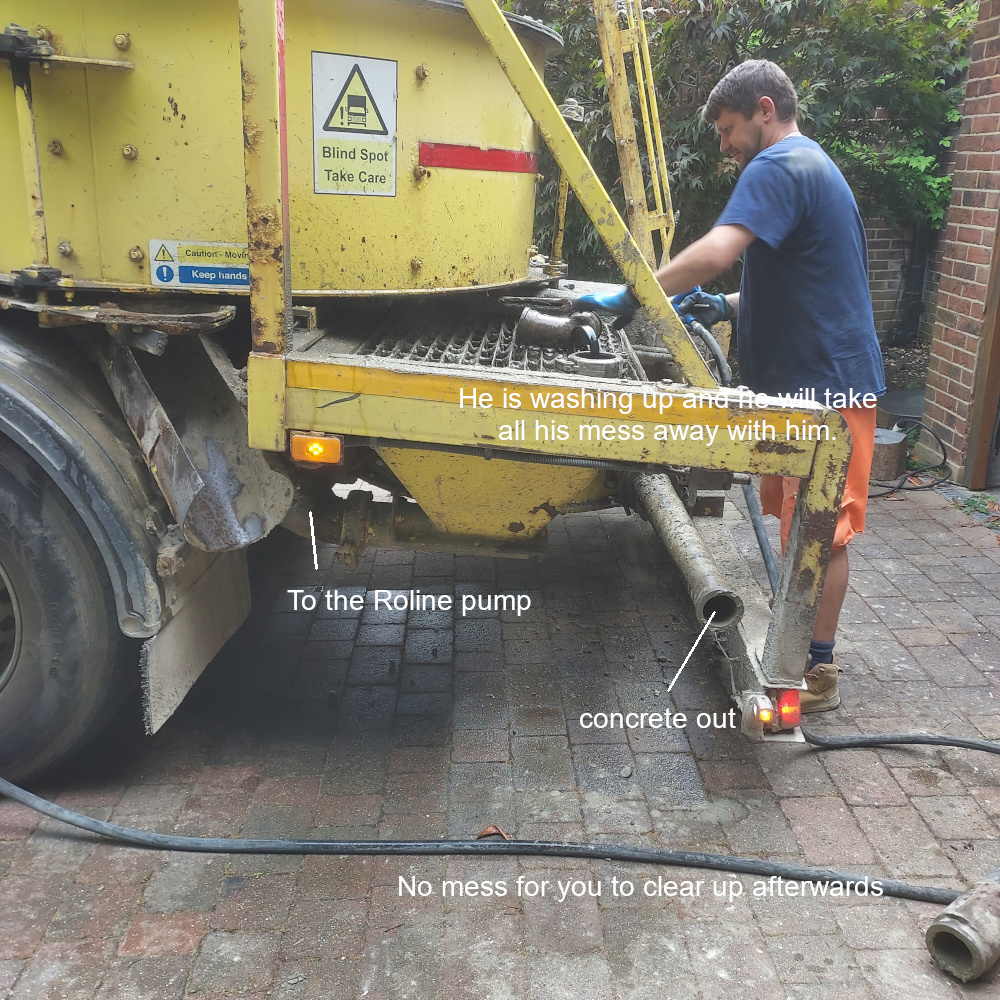
I cannot over stress that top quality concrete every time, and two hours working time every time, is absolutely invaluable compared to what goes wrong on occasions using a drum truck.
Added to which is the fairly gentle rate of discharge meaning that two men can work all day instead of 5, 6 or 7 getting paid a whole day each to only work hard for 2 or 3 hours.
All standard boom pumps and line pumps wash their hoppers out to the ground, wasting about a third of a cubic metre of concrete. Mixamate pumps waste less than a bucket of concrete and they can take all their wash out mess away with them, leaving your site clean.

Sometimes the boom pump or line pump hopper is emptied and washed out in the street. You mustn't block the drains and you mustn't leave any for your neighbours to drive through and splash concrete on their car. It is an extra hour of hard work moving nearly a tonne of concrete and a lot of dirty water.
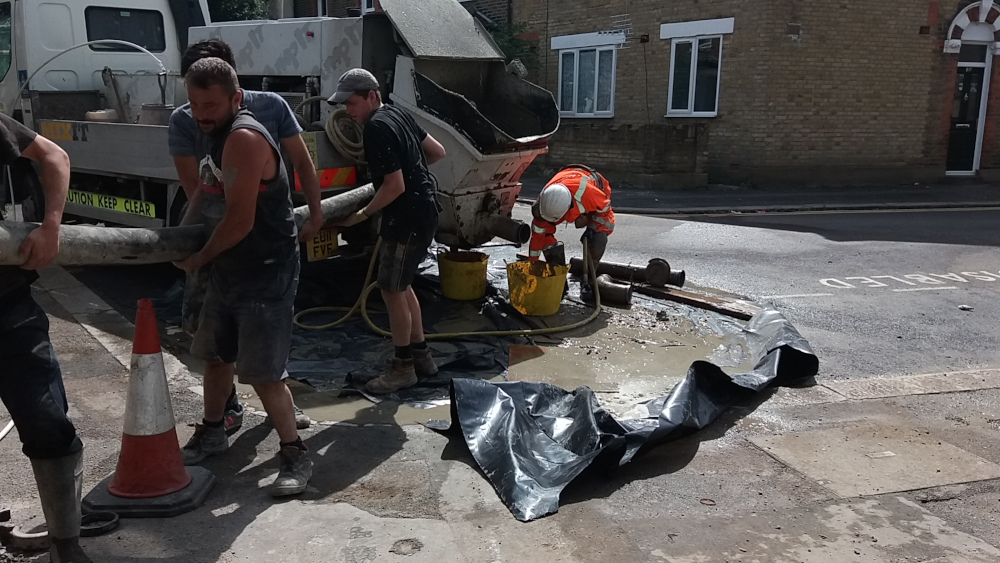
The standard 4" line pump weighs about 100kgs for the last 3m full of concrete. It is hard to bend to your will and heavy to drag around.
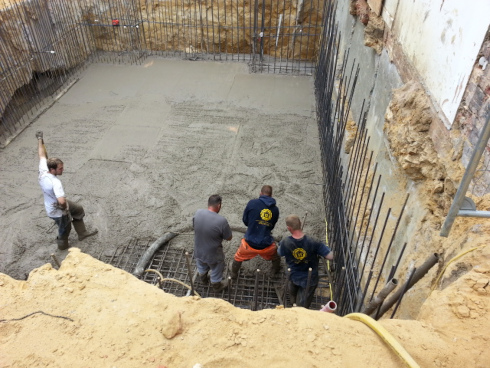
|
|
|
Whereas the 3" Mixamate line is much lighter and more flexible.
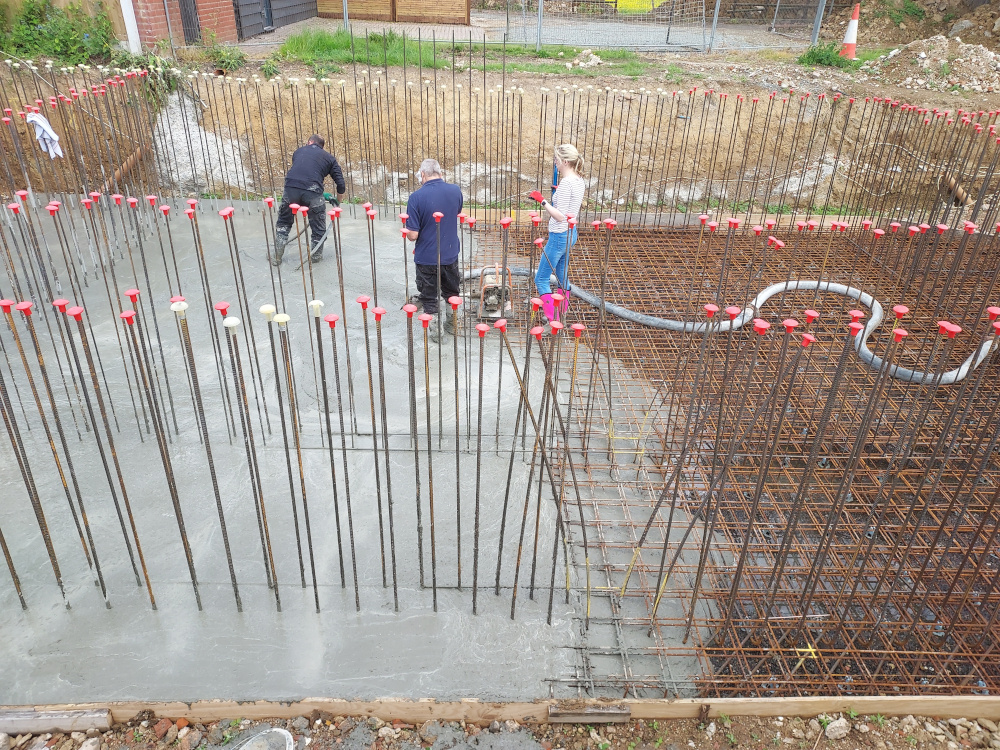
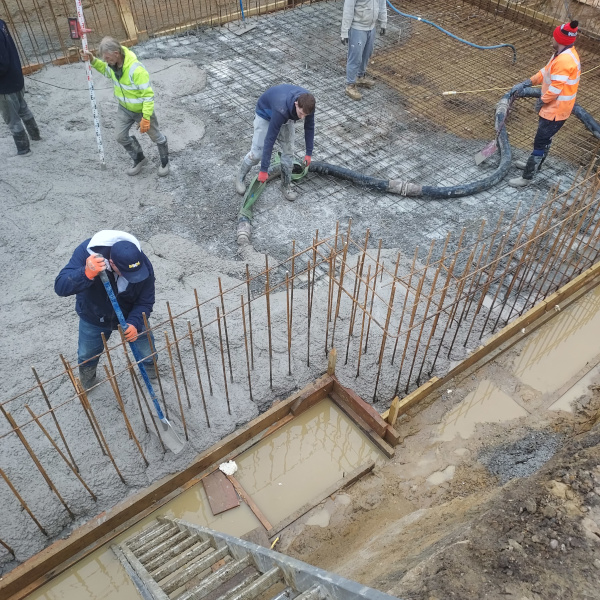
|
|
I describe, lower down, an awful day using Cemex. The batcher would not put enough water in, and the office later told us the computer recorded more water than the limit I had set.
The journey times on the delivery tickets were a little over an hour. Yet the concrete arrived with every load setting.
Every department seemed to let us down then lie about it. (I wrote and invited them to sue me for slander). The set concrete underneath is from the Cemex plant at Datchet, 11 miles from the site. London Concrete were used the following day to cover it over and finish the floor.
But water content is only half the story.
The first London Concrete arrived in good condition. But the second load was not in good condition for long enough to do all the work required.
Google maps says that on a Sunday morning both journeys would take a car about the same. 23 minutes or so. In fact, the minimum for a car from Colnbrook was 22 minutes. Yet, the London Concrete electronic Ticket says the concrete was en route at 11.06, Wednesday 12th June 2024. I was able to read the QR code on the side of the truck and download the Ticket at 11.36.
|
Is it feasible for a heavy truck to complete that distance, including 7 junctions and 6 roundabouts, in 30 minutes on a Wednesday morning when a car should take 22 minutes early on a Sunday? Bearing in mind that there is usually a delay going south on the M25 approaching junction 11 and usually a delay approaching the traffic lights at the roundabout off that junction to turn right because cars use the left hand lane and many cut in to the right at the top. Further back, a truck would barely advance each sequence of the lights.
You can see the exact route for yourself.
Or do concrete companies have the ability to alter an electronic delivery ticket before the concrete arrives and the customer gets their Ticket?
Delays, holdups, road works, accidents, incidents and school times are out of the customer's control. But the quality of your finished concrete suffers from any of them on the day.
This is London Concrete concrete as well. At Rickmansworth, batched at Watford.
It was not a very good team of labour. They said they would go back and fill this depression. But the concrete had set and they couldn't.
For months, they walked through 60mm of water, getting wet feet.
I cannot stress enough how valuable working time is for you and your project.
Mixamate always gives you more working time.
|
|
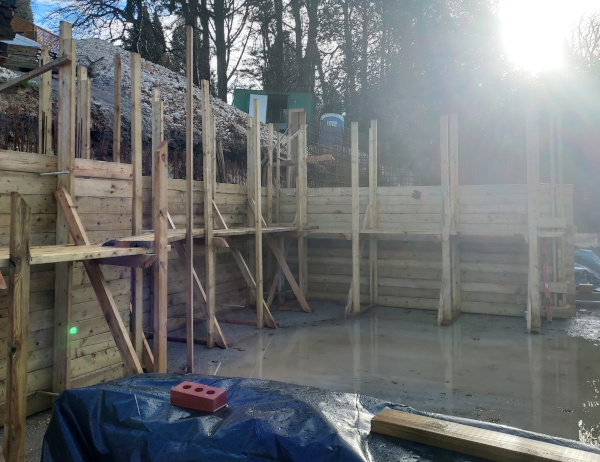
|
Mixamate have 28 of the trucks with their own pump. When the first is empty, the next can arrive and carry on. Two can connect and deliver concrete at twice the speed, if you have the space.

The clients at Maldon, having used Mixamate for the floor slab laid by only the father and son, decided that for the walls they would use a boom pump as well.
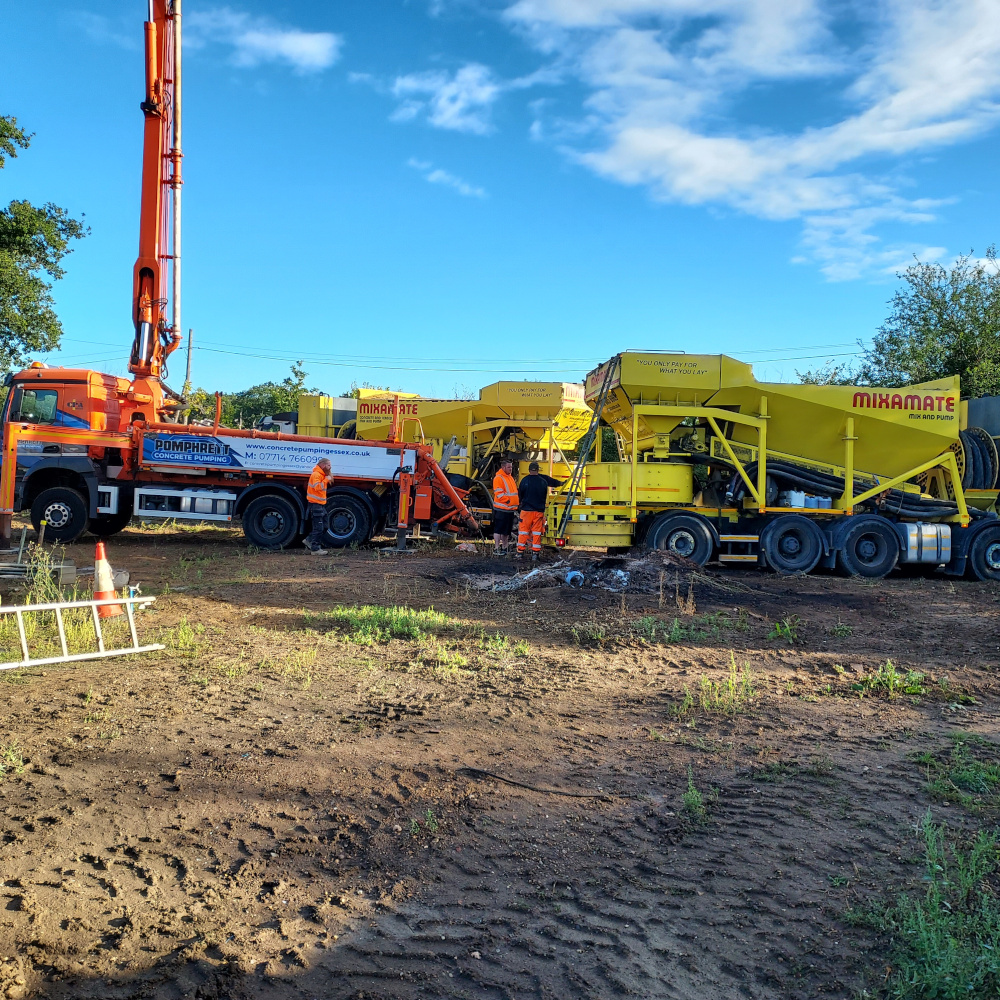
They chose Pomfrett from near Colchester who have a very handy flat rubber tremmie pipe that delivered concrete between the faces of wall steel at a steady trickle.
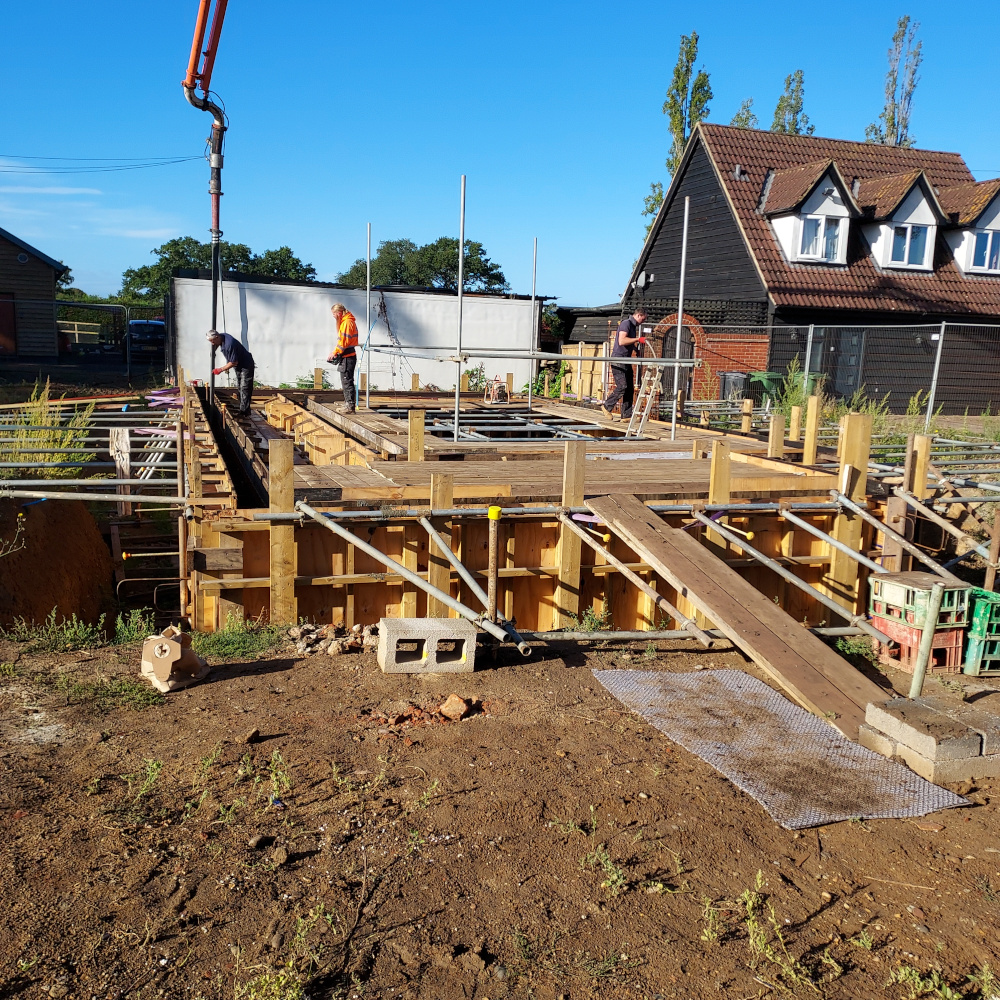
They coped comfortably. 38.7m³ by 3pm.
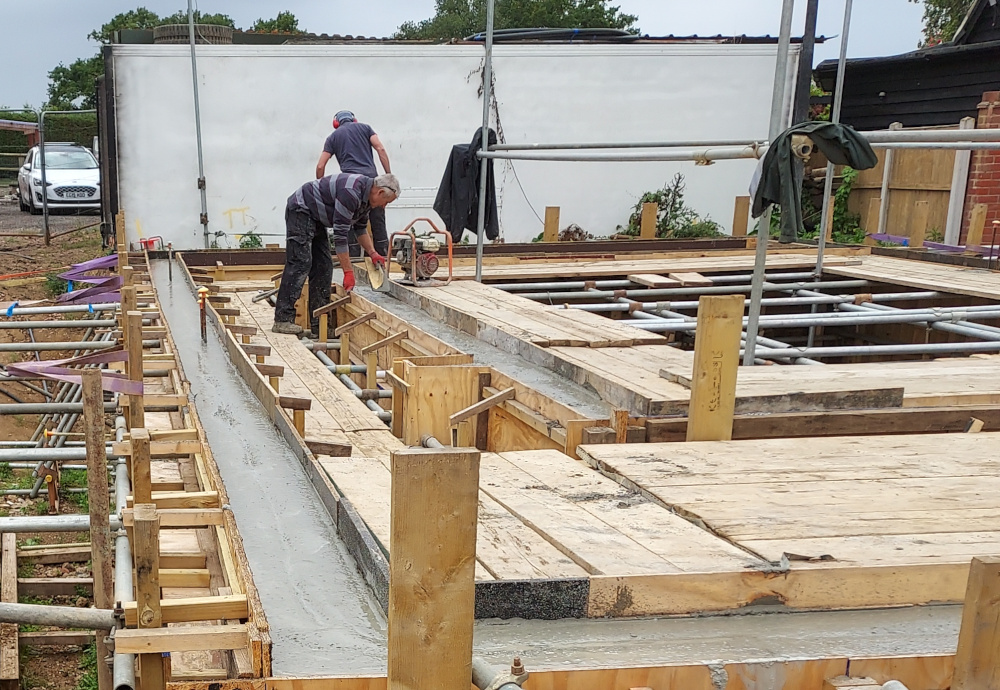
Mixamate employ a highly qualified technical manager and they have a test lab. Quality control is a priority for them.
3. Why I say you must never use a volumetric truck for high quality concrete.
Do you need High Quality Concrete?
You need high quality concrete if
-
You want your concrete to be resistant to water.
-
Your concrete is specified with a minimum strength requirement.
-
Your concrete needs to be designed to a Class of Chemical Resistance. E.g. DC2
You need resistance from
- oxygen
-
chloride ions
-
carbon dioxide
-
any other potentially deleterious substances identified in your soil report
-
Your concrete needs to be designed to a specified Exposure Class. E.g. XC4
This image is from Ebay.
The tell-tale sign that the volumetric is the type I am talking about here, is the tube with a screw that lowers down at the back.
|
|
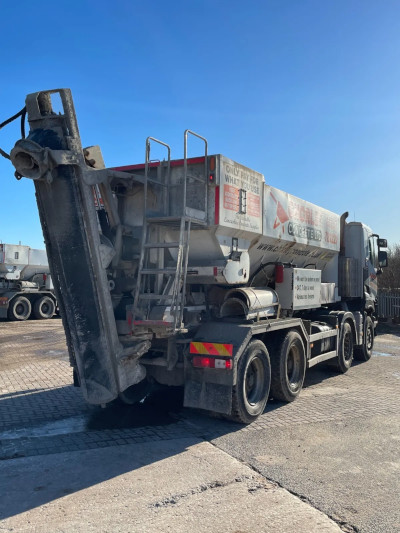
|
I need to say at the outset, volumetric truck manufacturers offer extra features to those who will pay for them.
But customers shop around on price. The concrete suppliers who advertise mostly buy a cheaper truck without extras, and if one of their competitors found a way to cheat and appear to be cheaper on the phone, the others will have to use all the same tricks to compete.
-
They carry only ballast. Ballast is as-dug out of the ground with clay and silt removed. It is not dense. It is full of voids. Unless your concrete has a lot of extra cement powder to fill all the voids, which costs you a lot more, your concrete will be weak and porous.
-
They have a meter which tells them how much concrete you used. But if they reduce the figure they tell you equates to one cubic metre by 20%, you pay 25% more for the true amount of concrete you used. Because every time you use 4 cubic meters they tell you that you used 5.
-
They may not have enough of something and don't go back for more before they come to you. Because to lose an hour and spend more on diesel to top up the water, cement or ballast means they can sell less concrete that day. They sometimes make you poorer concrete than you ordered to eke out the material they know they are short of.
-
The driver is controlling the speed of the conveyor, which alters the cement to aggregate ratio. Not the computer. He can reduce the cement and reduce his cost.
-
The amount of water in the concrete isn't consistent until the driver gets the hang of what you seem to want. He turns the tap. More water increases the volume and increases his profit. But it produces weaker concrete.
I used a volumetric for concrete blinding (2022). It was the site manager's mate. He chose them. The driver was smart and clean, which is unusual, and he refused to put more water in for me because he wasn't carrying enough. So I had to hurt myself struggling to spread stiff concrete. Of course, the site manager said he had a bad back and he refused to help.
|
4. What a big producer is capable of.
Before more about the day with Cemex.
It isn't the only day it went wrong with Cemex.
Around about lock down, I was able to work outside with two others so we carried on. The roads were quiet.
I had concrete on order provisionally until the pump had arrived.
But the concrete turned up early, before we had the pump.
Someone told me that the technical department who had spoken to me about the mix, had also changed the order from provisional to confirmed.
Speaking to the driver as he waited, he confided that something like this happens every day, and everyone who could be involved would be working hard to protect themselves. That is why no one was telling him what he should do. It had to be seen to be someone else's mistake, and they should sort it out.
They kept the poor driver outside for two hours till they decided where to send him. His concrete age was now the journey to us, the 2 hours outside, and his final journey old before he could discharge. The concrete would be solid. Poor bloke. Far too late to add sugar, I think. Chiselling setting concrete till late into the night, probably.
Cemex continued.
I am choosing to blame Cemex's dumbing down of the batchers who actually make their concrete and load their trucks. And their shipping team who don't seem to understand how slow the roads are in and around London, especially Surrey. And, I suppose, sales for accepting an order they can't supply.
The batcher was a foreigner who I could only partially comprehend and who seemed as unwilling to hear as he was unwilling to understand.
Cemex management is divided into clear disciplines, such as sales, shipping, technical. They don't seem to talk to one another. They send messages, which are easily ignored. (Or, at least, not read immediately).
When the driver of the first load returned with the third load, after I had been trying my hardest to make the batcher add more water, he said he told the batcher the same but the batcher refused.
During the debrief with Cemex
My phone calls at the time, sometimes on the client's phone, explained that the concrete wouldn't discharge. It was that dry. Dryer, I would say, than the 34% Breedon seemed to have supplied (see further down in section 7). The batcher was saying much the same as the Breedon batcher. He knew how to make S2.
In subsequent emails
"
Following the internal investigation carried out regarding Mondays rejected 3rd load please find the attached invoice for return load charges for the rejected material.
As per BS EN 12350-2 the maximum allowable deviation based on a spot sample taken from the initial discharge of a ready-mixed concrete truck for target slump (mm) 50-90 is ± 40mm. Therefore, as the material was ordered on a 60mm slump the tolerance for this sits between 20-100mm.
Due to the material being rejected without being slump tested on site we have no evidence to prove that the material was not with in the required specification, therefore it is the view of the business that the supplied material was within spec and return load charges will stand.
Following a conversation at 0919 between Lewis Archer in CEMEX Internal Sales and Philip Sacre on site, load 3 was put on hold pending the successful offloading of the second load. At 1022 load 3 is released by Kevin Egan in CEMEX London Shipping following a call with (client) on site as (client) is chasing for the 3rd load to be sent. No changes to the material are requested at this point.
As no changes were requested to the material ordered following the offloading of the second truck it is again the view of the business that the material received on site was within the requested specification and return load charges will stand.
"
"
We also note that water was added to the delivered loads. As per our terms of sale, this then puts any liability for the concrete with the customer.
"
I responded
"
But, Lewis told me over the phone, after the third load had arrived, I think, that the technical report he had, stated that the P350 over-sanded mix with no additives of your own and a target slump of 60mm at site was made with 193 litres of water per cubic metre. I presume he meant free water. That would be a WCR of 55%. Plenty of water to get an S2 or even S3. I think that somewhere the system recognised that with only CEM 1 (pure OPC) going into the concrete, that 193 litres was the minimum to avoid ASR.
"
BUT THE CEMEX BATCHER OVER-RODE THE SYSTEM. EASILY.
From the Cemex website.
All CEMEX batching plants are fully automated and controlled by the GINCO system. The system automatically controls the exact batching requirements of each mix design to ensure consistency and accuracy of constituent parts.
BUT THE CEMEX BATCHER OVER-RODE THE SYSTEM. EASILY.
THE COMPANY USES ITS GINCO SYSTEM IN DEFENCE. WHILE THE BATCHER DOES WHAT HE LIKES.
|
5. Waterproof Concrete Admixture Suppliers.
I found some interesting comments on the Maclennan Waterproofing web site here.
This is truncated and I have edited bits together: "We work on 4–6 failed waterproof concrete basements a month where the additive companies have left the contractor and engineer with a water ingress problem to sort out. fail(ures) due to poor workmanship, cracks, honeycombing, and most commonly defective joints, hydrophilic strips and water bars".
I found the guarantees given by some of these brands.
None of them seem to guarantee anything beyond what should be expected of structural concrete without any water-resisting admixture.
There are two examples of the Caltite guarantee on this web page. Where Caltite might have misled you is confusing the fact that Everdure Caltite, that contains a polymer, will waterproof non-waterproof concrete if the concrete is first kept moist inside and fully cured (which might take a month) then oven-baked long enough to dry the concrete and the polymer completely. They may have shown you an example where concrete above ground in Australia did exactly this. But beneath ground in Britain the polymer could not and will not work. Indeed, academic evidence is that if the polymer does not dry out it actually increases the transportation of water through concrete. The opposite effect.
You need to go to page 26 to find the exclusions in this Sika guarantee. Over the years I have had a few phone calls from people whose lives have been severely blighted by new basement construction suffering seemingly incurable waterproofing problems. All the worst sagas involved Sika. I was once called by someone calling himself a Sika sales manager who claimed this claim of mine was untrue. I was able to give him the phone number of one of these unhappy people. I didn't hear from him again.
If you go to the Kryton web site It all sounds very good until you realise that, like Sika, they are selling some extra cementitious powder and they promise only what extra cement will achieve. 0.25% extra cement does very little. But to say more water resistant, stronger, more durable would all be true even if only 0.25% true.
Pudlo and Xypex are selling extra cementitious powder as well. Let us not forget that the David Ball Group, that includes Pudlo, have a leak repair division as well.
Actually, the clever ingredient in every one of these admixtures is not a waterproofer but a powerful plasticiser. I am using the sixth I have found, each time having found better, and people who know tell me mine is best. Obviously, it is also the most expensive I found as well.
All powerful plasticisers are based on PCE, polycarboxylate ether, which is a very long molecule that clever chemicals can be fixed to.
Producers invent their own combinations of clever chemicals and patent them.
PCE with clever chemicals are used in concrete admixtures for a variety of uses, such as plasticiser, retarder and so on, and also in inks, paints and cosmetics.
Powerful plasticiser is a combination of PCE, electrostatic repulsion and glue.
The electrostatic repulsion isn't greatly different to naphthalene super plasticisers invented over 50 years ago. But with naphthalene it was liquid repelling liquid and its effect was limited.
PCE powerful plasticisers stick to the cement grains so that the solid cement grains are repulsed from each other and friction is reduced many times more than it was with the older technologies.
PCEs vary enormously. To have sourced a PCE is a long, long way from having sourced a very powerful plasticiser.
Beware of liquid PCEs. The 'glue' soon falls off after the stock arrives in the UK from the Far East. They effectively revert to a 50 year old super plasticiser technology in terms of effectiveness.
Never allow a liquid PCE plasticiser, which must include Caltite.
Every one of these product BBA certificates or the product literature or the safety document confirms that all allegedly waterproofing admixtures for concrete contain a water reducing plasticiser. I believe the rest of what they say to be smoke and mirrors.
Since 2013 I have travelled to the USA and Asia many times looking for better and better plasticiser. The one I have now is very powerful indeed.
Waterproof concrete is so dense nothing can get through. But this very dense mix would be too dry to pump and properly compact. It (only) needs very powerful plasticiser.
I put my powerful plasticiser into the concrete at site.
It is the only way I can be sure that the batching plant limited the water content.
The concrete arrives with stones rattling loose in the drum and the concrete breaks apart as it is turned slowly.
My powder is added and I count 6 revolutions per cubic metre. It is quite clear, listening to the concrete, that my powder works because it becomes more workable, the stones stop rattling and the truck becomes stable and peaceful. Whereas it lurched at the start each time a huge volume of dry concrete crashed as the drum turned.
I feel that adding my admixture at site is the only way I can be certain the concrete has less water and that my plasticiser is definitely working.
None of the brands do this, as far as I am aware.
In particular, how could a liquid brand like Caltite know whether the tiny amount of essential powerful plasticiser within the 30 litres of mostly bituminous emulsion still works? Hasn't fallen to pieces?

|
|
Pudlo used a control concrete without admixture a lot more water resistant than the concrete other brands achieved even with their admixture.
Proving that waterproof concrete is at least as good as the Pudlo concrete with Pudlo in it. Or, perhaps waterproof concrete is a lot better. Perhaps it is zero and off the bottom of the chart by miles.
The proper test for waterproof concrete is BS EN 12390 part 8. But no BBA testing involved this proper test. (Only I seem to have used this test. Every sample of my waterproof concrete passed with flying colours. Examples lower down.)
Pudlo's improvement wasn't greatly different to the improvement others obtained. If Pudlo was added to any of the others' control concretes, it would not be significantly different.
|
I think Pudlo continued to cheat long after they got a BBA certificate.
Pudlo have had presentation to specifiers slides available on the internet. This image is from that presentation.
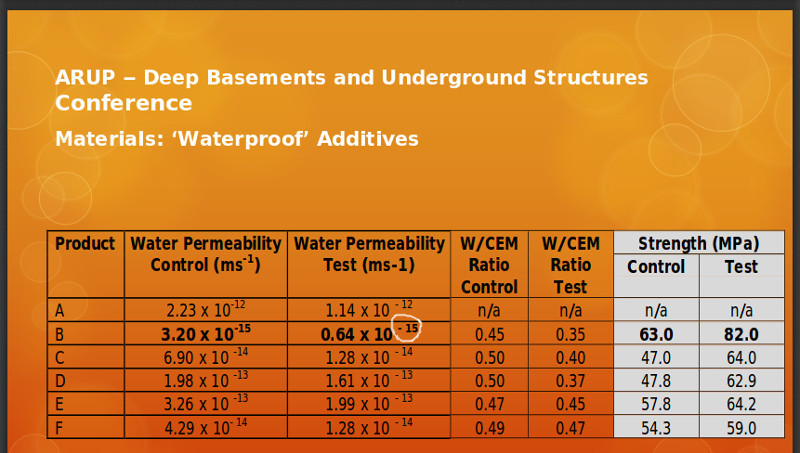
They highlight in bold, I added the white circle, a figure a thousand times better than the figure above, which is Caltite. These are the same figures from BBA certificates plotted on the chart above.
This table would allow you to believe that Pudlo is 1,000 times more effective than the product above. Whereas the chart shows you it made a similar tiny improvement comparable with the others.
If you look at the water cement ratio figures to the right of my white circle, the ratio in the control is 0.45, while the ratio in the test was 0.35.
10% less water by weight of cement could not be explained just by adding more cement to the control concrete, because 45% of 350kgs is 157.5 kgs or 157.5 litres of water per cubic metre of concrete.
To reduce the WCR by 10% to 0.35 would require another 100kgs of cement per cubic metre of concrete. Exactly 450kgs.
I have seen Pudlo at a batching plant. The paper bag could easily be held in a hand.
It weighed nothing like 100kgs. Probably about 8kgs.
Significantly reducing the water this much surely means three things.
-
They doctored the control concrete before they added their product by reducing the water in it. Cheating.
-
The concrete was made with insufficient water to make the 5% gypsum in OPC react first, meaning the concrete had a flash set instead of 2 hours working time. If this concrete was delivered to site it would barely come out of the drum. It would not go through a pump. It would take many more men the same time to spread it, compact it and finish it.
-
The grains of cement are not pushed apart at all. Pudlo seem to have managed to compact their test sample and, properly compacted, it would be a very strong and waterproof mix. Which is why they reduced the water in the way they did.
The massive increase in strength is only slightly because of their product. It is mainly because they reduced the water content.
If you think Pudlo is better because you saw this slide, you might now think you were duped.
Some time after I wrote this page, the David Ball Group that includes Pudlo went into administration.
This link opens a press article.
We will have to wait and see whether Pudlo reappears, and whether any guarantees will be worth anything.
The chart above is from a paper by the Concrete Society (cited in section 8 below). It is some of the figures from BBA certificates plotted together.
The figures in the Pudlo slide are the same, this time including Caltite.
This my chart. All the same figures including Caltite's that are no better than standard structural concrete.
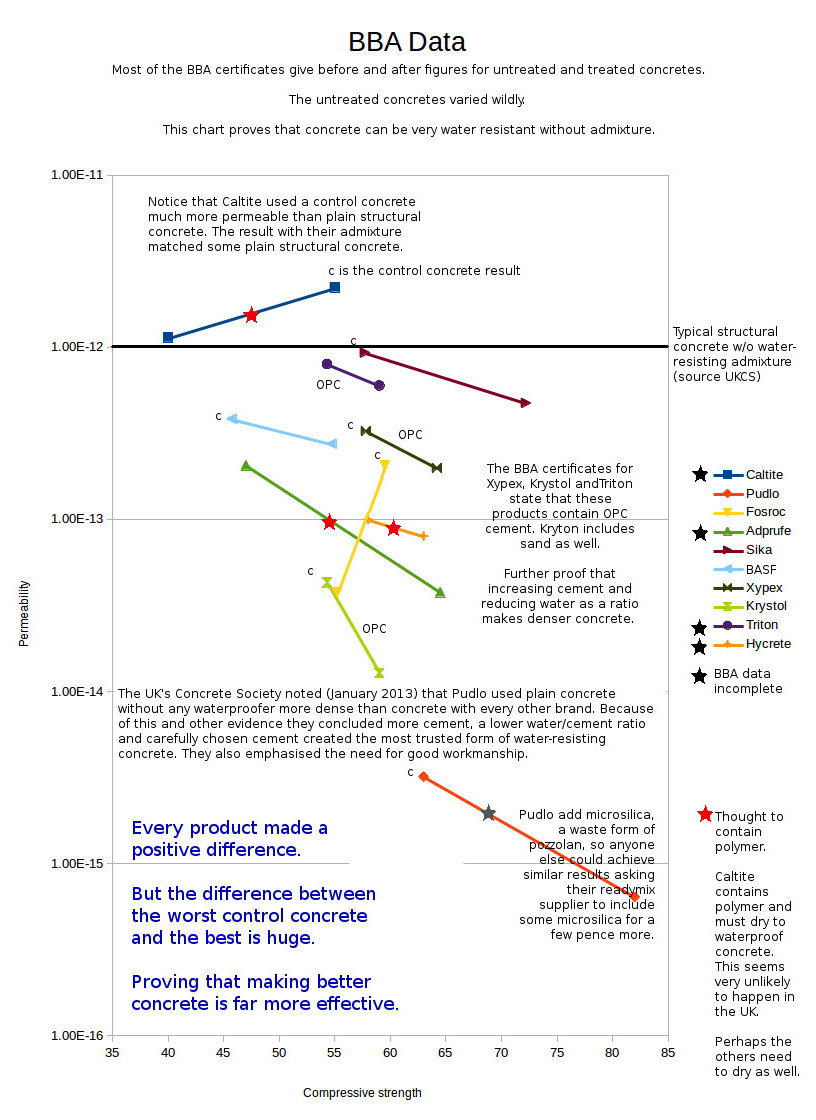
The Caltite admixture made the concrete weaker.
|
|
6. Proving that you have Waterproof Concrete.
First, the official test. Lower down the unofficial test.
BS 8102 deals with the waterproofing of beneath ground structures.
From 9.1 of BS 8102:2022 on page 36.
"Concrete structures containing a water resisting admixture should be deemed to have a lower degree
of water / vapour transmission when the design of the concrete mix and casting of the structure is
adequately supervised and the admixture is assessed and certified (see 9.2.1.3)."
I deal with 9.2.1.3 in the text box 'What academia says about Waterproof Concrete'.
"Where the waterproofing admixture has been assessed and certified by a UKAS-accredited body or
a European Technical Approval body, certification information should be referred to for guidance on
use and the extent or limitation of technical benefit."
On page 53 of the new BS 8102:2022, BS EN 12390 part 8 is quoted.
|
|
Click on this image to open an original test certificate.
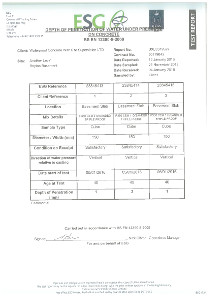
|
This is the start page on the British Standards web site for BS EN 12390, Testing Of Hardened Concrete.
Part 3 is used thousands of times every week: Compressive strength of test specimens
Part 8 is Depth of penetration of water under pressure.
Official test.
|
Here is a photographed extract from my copy of "Advanced Concrete Technology", the volume called "Processes", the Chapter called "Concrete construction for liquid-retaining structures" by Tony Threlfall, 2003, Butterworth-Heinemann. Page 16.2.
|
|
Click on this image to be able to read the text from the whole page.
|
|
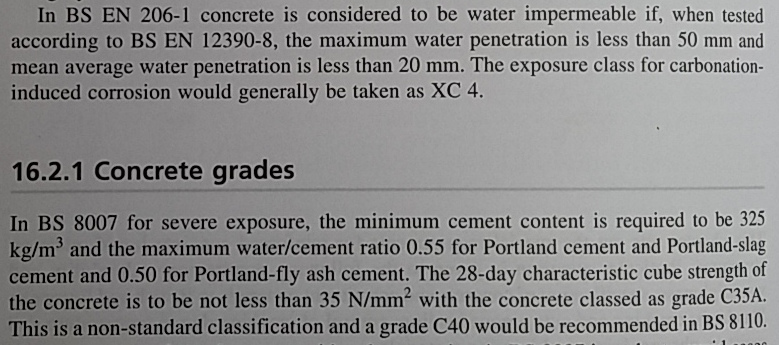
|
The pass mark for BS EN 12390 part 8, depth of penetration of water into hardened concrete, is 20mm.
If your architect, structural engineer, building control officer, warranty provider or lender insist on you using a product with a BBA certificate. Fight back. They will think they are still correct trying to meet the 2009 version of BS 8102. They are not meeting BS8102:2022. Go here to the
BS8102 page where I reveal the truth behind BBA certificates. This is the same as the link above.
Nowhere does BS 8102:2022 mention BBA or BBA certificates.
Another certificate. ESG became Socotec between 2016 and 2018, but they are from the same lab.

Unofficial test
I have some cube samples sitting in water at a site in Epsom, waiting for me to crack them open.
Last year, I had to go back to a site and chisel out some concrete to make room for a bolt or something.
The concrete was green inside, but by the time it occurred to me to photograph it, the surface had already turned grey with humidity from the air.
September 2025. I am going to crack open two cubes made on June 18th. Struck and placed in water on August 22nd. I will photograph the fracture and return the pieces to the water. Weeks later I will crack open the fragments and photograph them again.
The photographs will be put here.
If concrete, made by Mixamate and from concrete poured in the slab, remains green inside while sat in water for several months, then obviously water is not getting in at all because, otherwise, the remaining cement would react and turn grey inside the samples.
Proving that the concrete is waterproof.
|
|
7. Waterproof Concrete explained. The science in simple language.
Waterproof concrete is a specific mix of completely normal aggregates, normal cement and (normal) water.
Waterproof concrete has extra sand to completely fill all the spaces between the stones.
Waterproof concrete has extra cement to completely fill all the spaces between the sand.
Waterproof concrete also needs a powerful water-reducing plasticiser to reduce internal friction and add workability to an otherwise too-stiff mix.
Waterproof concrete has a lot less water so that grains of cement are not pushed apart. Grains of cement probably touch neighbours in the fresh, wet waterproof concrete mix.
Normally concrete has more water that pushes grains of cement apart reducing the friction and adding workability, which is why extra water is very popular with labourers. More water significantly reduces the amount of work they need to do.
But more water weakens the concrete, increases drying shrinkage cracking, and makes concrete more porous. The problems caused by more water in concrete are unpopular with clients.
As the surface of each grain of cement blends with the surface of the water against it, gel is formed with a slight expansion. The gel turns into long, thin, crystals.
The closer the grains of cement are to each other in the fresh, wet concrete, the more crystals from one grain get tangled (interlock) with crystals from neighbouring grains.
It is this continuous skeleton, of crystals from every grain of cement interlocking throughout the concrete with crystals from every neighbour, that gives concrete strength.
The less water, the thicker the continuous skeleton and the stronger and more water resistant the concrete.
Therefore, the biggest difference between waterproof and non-waterproof concrete is the water content; and the second biggest difference is the amount of sand and cement.
There is no chemical or additive that can be added to non-waterproof concrete to make it waterproof if it is to be used below ground where it could not be baked dry.
If your waterproof concrete arrives and the labour add more water, it isn't waterproof any more.
More water takes up space and pushes grains of cement apart. Crystals get produced around every grain but water remains between crystals surrounding each grain, leaving water-filled routes (porous) throughout the concrete.
How much water is the correct amount of water ?
This is actually quite tricky, which is why the poorly educated people who operate batching plants get it very wrong.
Cement contains gypsum. (You can ask Google 'why does cement contain gypsum' for more information).
If there is sufficient water, but only if there is sufficient water, the gypsum reacts first and coats everything with ettringite to stop the cement itself from reacting. This gives fresh concrete about two hours working time to mix it, deliver it, place it, and finish it, before it starts to set.
If there is not enough water, then the cement itself reacts immediately and it will be setting hard during its delivery journey. Difficult to even get it out of the truck when it arrives. Adding more water now will only make it react faster. It won't make it flow.
About half my projects looking back 20 years had this problem at the start. A phone call mostly got more water added from then on. The first concrete is always for the floor slab. I spread this stiff concrete only in the bottom half of the slab. Poker it. Then cover it over later when the mix is correct. Prematurely setting concrete is very strong concrete, just difficult to place and finish.
-
In October 2012, I watched and filmed a load of concrete being discharged. It was Sika waterproof concrete admixture batched and delivered by Euromix. The truck driver used all his water, then most of the water carried by the concrete pump, trying to push the concrete down the chute into the pump with his feet.
I am extremely critical of Sika on this web site, and always have been. I think they promised Euromix assistance but failed to provide it.
Here is what a Google search turned up today.
AI Overview
Yes, Sika can send a watertight concrete specialist to a batching plant, particularly if the project requires a Sika guarantee, in which case site visits by Sika technicians are provided free of charge. Even for projects not requiring a guarantee, Sika offers support on a project-by-project basis for watertight concrete, including technical advice on product selection, pour schedules, and joint sealing, to ensure a fully waterproofed system.
None of that happened that day in 2012.
-
One batcher unwittingly explained his logic and the cause of the problem. This was summer of 2023. The batcher worked for Breedon concrete near Bridgend in south Wales. He said that he adds one amount of water for S2 and another for S3. (I'm trying to remember the numbers accurately, but the story is the same even if I'm mistaken). 800 litres for S2. 1000 litres for S3. I wanted S2, therefore I got 800 litres.
Never mind all the clever equipment measuring the water content in the sand and how it varies in the top of the heap and the bottom so that the computer tells him exactly how much to add to that particular mix design. No. He overrides all that.
But for me, he ignored that the 350kgs of cement I want per m³ requires more water to have the same water to cement ratio as a batch for footings that might have 220kgs of cement per m³.
If 800 litres is good for 220kgs, then the same effect with 350kgs of cement needs slightly more than 1200 litres.
He did add more water from then on. Enough to avoid the flash set, even if not enough for the slump I wanted.
-
But, in particular, I remember Cemex on 8th April 2024, near Woking. All 3 loads arrived hot and stiff. Each stiffer than the load before.
I went through this further up the page after section 4.
-
And two suppliers to a client in Kent. First, in January, the client fell out with Coppard Concrete after they decided to stop batching at Crowborough and send a load from Godstone. This had to go through the M25 roadworks forming laybys that had nearly always caused long delays for about a year previously. The concrete already in the pump (the concrete from Coppard at Crowborough and the pump from Coppard at Crowborough as well) had set stiff and the pump needed to be driven away and cleaned in their workshop.
But you would expect Coppard Concrete to warn their Coppard pump operator colleague there would be a delay, and to wash out while he waited. It is as if they had no idea.
The client was sent a huge invoice for cleaning that I told him not to pay.
-
So, the client in Kent turned to Gallagher in Tunbridge Wells. I went to see Liam, the batcher, and explained about the water. We need enough to react first with the gypsum, but not so much that the concrete won't be waterproof. He basically said he understood and to leave it with him because he knows what he is doing.
The amount of water needed to be able to pump the concrete after powerful plasticiser is added is significantly more that the amount of water needed to make the gypsum react. If the gypsum has not reacted then the concrete is really very dry.
The first load arrived for the first pour. It was too dry for the slump so I asked for more water. This kept happening. It felt as though I was punished with less and less water the more I phoned.
Another pour, I think in June 2025, and another phone call to Liam. He summed up the situation thus: "You want stiff concrete and you have stiff concrete".
All that science out of the window. Liam only supplies runny or stiff.
The mat of crystals in waterproof concrete gets thicker and thicker
until remnants of grains of cement are left trapped one side of the mat and remnants of water are left, sealed in tiny pockets, the other side of the mat.
When no more water can reach remaining cement grain all reaction stops. The concrete is waterproof.
That is ....
until ....
there is a crack.
Concrete warms up and expands when it cures and cools down and shrinks as it cools, usually a day or two later.
It is inevitable that concrete will crack upon cooling in parts of a concrete structure that are restrained at the ends. In my experience, a 20m long basement retaining wall of waterproof concrete made with pure OPC will shrink about 4mm.
The 'trick' is to have sufficient horizontal steel reinforcing bars that grip the concrete either side of a crack instantly and prevent that crack opening more than 0.2mm.
This will make the concrete crack again and again until all the cracks add up to the total thermal shrinkage which, in my example, is 4mm over 20m, which requires 20 cracks if each is 0.2mm wide.
When waterproof concrete cracks it is the continuous mat of interlocked crystals that cracks. Unused water will find remnant of cement grain and the curing process begins again. A crack up to 0.2mm wide will completely heal. This is called autogenous healing.
Some other concrete elements, such as basement floor slabs, are not restrained and can expand then shrink as a whole without cracking.
Non-waterproof concrete will always be weaker and more porous than waterproof concrete because the waterproof concrete is a better blend of solids and less water pushing the solids apart. Increasing the water increases the amount of cement that is turned into crystals but extra water reduces the amount of crystals surrounding one grain of cement that interlock with crystals surrounding each neighbour.
Note that cement blends are likely to get less hot and shrink less on cooling. But you rarely know for certain what cement you will get. Plants run out and use something else till their silo is refilled. And you get lorries from a mixture of plants sometimes.
These two sections, numbered 6 and 7, are a repeat of some of the knowledge on the My Credentials page.
6. The differences a different amount of water makes.
Less water.
From Understanding Cement. A book by Nick Winter.
aluminate hydration in the absence of sufficient available sulfate in the cement pore fluid rapidly produces Afm phase ... this results in a flash set.
Too little water can cause a FLASH Set.
That means that the Portland Cement is setting. Stiff. Getting warmer.
Whether the concrete is setting because the truck was stuck in traffic for two hours, or it is setting because there is not enough water to dissolve the 3%-5% gypsum added to Portland Cement to give working time, is indistinguishable at site.
But the result is the same. The concrete will barely come out of the truck and it will not pump. The strong alkalinity of the setting cement kills off water reducing plasticisers, mine anyway (though triple dosing my powder does give a few minutes respite), and adding water just makes more cement react, rather than making the concrete sloppier.
More water.
From Understanding Cement
Figure 6.3 Polished section of cement paste, age 2 years, made using ordinary Portland cement, w/c=0.40. Key: c - unhydrated cement; C-S-H - calcium silicate hydrate; CH -
calcium hydroxide; p - pore; Circle 'A' contains
C-S-H, CH and is assumed also to contain AFm and AFt phases. CH is just visible, AFm and AFt are not visible as they are too small.
|
|

|
The cement paste shown in Figure 6.3 contains the following features:
-
Partly-reacted cement particles (c); the remaining unhydrated material appears very bright in the SEM image. These particles have reacted to a considerable extent, as shown by the dense rims, composed mainly of C-S-H, that surround them.
-
The outer edges of these rims indicate the approximate size of the original
cement particle and the hydration products composing the rims have
therefore formed within the volume occupied by the original cement
particle. The hydrated material in these rims is therefore called "inner
product" or "in-situ" hydration product. Although it looks solid and dense in the image, calcium silicate hydrate is a gel and contains huge numbers of tiny pores, called gel pores, approximately 1 nm across (1 nm=10-9 m).At this magnification, the gel pores are far too small to be distinguished.
-
Elsewhere in Figure 6.3, there are smaller areas of dense C-S-H,
corresponding to smaller cement particles that have fully hydrated.
-
Also visible are areas of calcium hydroxide (CH) - these appear slightly brighter than the C-S-H but darker than the unhydrated cement.
-
"Circle A" contains CH (just visible) and also C-S-H. AFt and AFm phases (probably ettringite and monosulfate) are also likely to be present but are too small to be seen at this magnification. The hydration products in Circle A have formed in a region that was occupied by water when the cement and water were mixed; these hydration products formed from the precipitation of dissolved material are known as "outer product" or "undifferentiated hydration product".
-
Of particular importance in Figure 6.3 are the small black features; these
are capillary pores. Capillary pores generally range in size from a few tens
of microns down to less than 1 μm; these are the remnants of the volume
originally occupied by water when the cement and water were first mixed,
most of this original water-filled volume having been filled by cement
hydration products. The pores became filled with epoxy resin when the
polished section was prepared and so the black features are actually
epoxy resin, but the extent of the resin shows the extent of the original
pore system.
Now that you know what you are seeing in these images of cement paste, try
looking at the four images in Figures 6.4-6.7.
(My note. w/c of 0.33 is too dry to use at site. 0.40 is likely to be too dry even with my powder. 0.50 would be too dry without my powder. 0.60 is therefore common.)

Changing the water/cement ratio has clearly altered the microstructure of the pastes. Pastes made with different water/cement ratios contain similar features to those shown in Figure 6.3, but the proportions are different.
Compare the pastes with the lowest and highest water/cement ratios to see the greatest contrast (Figure 6.4, w/c = 0.33, and Figure 6.7, w/c = 0.60). Two features are immediately clear: at the higher water/cement ratio, the capillary pores are larger (up to about 10μm) and very numerous, and there is less unhydrated cement.
In summary, as the water/cement ratio increases:
-
The porosity of the cement paste increases.
-
The permeability of the cement paste increases.
-
The compressive strength of the paste decreases.
-
The proportion of residual unhydrated cement decreases.
Higher water/cement ratio concrete mixes are more convenient when placing the concrete, as it flows more easily. However, the effects on the cement paste listed above show that the consequences for the hardened concrete are strongly negative.
7. Concrete Permeability. (From Understanding Cement).
Concrete can be permeated by gases and liquids. Permeability is important principally because an increase in permeability is likely to result in an increase in the rate of concrete deterioration due to chemical attack or by freezing.
Assuming the aggregate to be impermeable and that no cracks are present, the only route of ingress is the cement paste. Paste contains capillary pores and gel pores but it is the system of capillary pores that controls the permeability of the paste; while the gel pores represent about 30% of the volume of hydration product, the gel pores themselves are too small to affect permeability.
The size of the capillary pores, and the extent to which they are interconnected, depends mainly on water/cement ratio of the paste. At early ages of hydration, it will also depend on the degree of cement hydration. From the images of pastes in Figures 6.4-6.7 it is clear that capillary porosity is reduced as the water/cement ratio decreases.
Minimising the porosity by minimising the water/cement ratio will help to improve concrete durability because its permeability will be lower.
|
|
8. What Academia says about Waterproof Concrete.
First, I promised elsewhere to return to 9.2.1.3 in BS8102:2022.
"
9.2.1.3 Concrete containing water resisting admixtures
COMMENTARY ON 9.2.1.3
There is a range of products, generally categorized as water resisting admixtures, which seek various ways to increase the inherent resistance of concrete to water and water vapour. As the mechanisms used each product to achieve these aims are quite diverse, it is not possible in this British Standard to give specific guidance on their use.
"
|
From the summary on page 55 of the report cited below: "Section 2 lists the types of materials that may be categorised as water-resisting admixtures and describes some of the mechanisms by which they may resist water penetration. However, the working party was unable to obtain details of the constituents in most of the commercially available water-resisting admixtures."
and:
It seems that with regard to water-resisting admixtures the available information has not been expanded
on from what was available nearly 20 years ago when Neville (see Section 4) commented:
"Unfortunately, little information is available to make it possible to explain and classify the actions
involved so that reliance has to be based on the manufacturers' data coupled with experimental
evidence on the performance of any particular waterproofing admixture".
A working group of 18 academics, major contractors, engineers and consultants decided to investigate whether and how corrosion of steel reinforcement might be prevented when the reinforced concrete was formed against sea water in the Arabian Peninsular. They sought to avoid stainless steel reinforcement by finding out how concrete might be improved to reduce corrosion.
They published:
The influence of integral water-resisting admixtures on the durability of concrete. Concrete Society. 2013.
For all the years since 2013, I have had my eyes open looking for clues. Cement and anything else that might be harmful has to be declared on safety documents. Cement and cement substitutes, such as calcium carbonate, are present in several brands including, I believe, in Pudlo, Sika, Xypex, Kryton and Triton.
In addition, all the brands require their admixture to be added to a very dense mix of concrete with limited water content.
It is my assertion and firmly held belief that water resisting admixture suppliers all want their admixture added to already very water resistant concrete.
The same report quotes the Pudlo BBA certificate, which is fairly typical of many BBA certificates for so-called water-resisting admixtures.
Pudlo BBA Certificate 01/3842
"Concrete containing the product will have enhanced resistance to reinforcement corrosion when
compared to the equivalent plain concrete". "Under normal conditions of service, concrete
containing the product is more durable than an equivalent plain concrete".
If more cementitious powder is added to an already very dense mix of concrete, it will make that concrete a little bit more dense and reduce the water cement ratio very slightly and the claims made on the Pudlo BBA certificate are exactly what you would expect.
Obviously, it would be easier and cheaper to ask the readymix producer to increase the cement content by the same amount.
At an exhibition, Kryton told me their paper sack contained sand as well as cement because the sand was necessary to break the paper sack open quickly.
In section 4, the report reviews the available information. They found that all the BBA certificates for water-resisting admixtures were based upon tests with very different control concretes, making the different brands impossible to compare side by side.

|
|
Pudlo immediately seems to be much better.
But, actually, if Pudlo had been added to the other control concretes it would have had similar results to those other brands.
Caltite is not here because the Caltite BBA certificate had less information. The report says the Caltite control concrete was not even as good as typical structural concrete. An academic paper cited in the report stated that Caltite only reduced transportation of water in much wetter concrete. It did nothing in low water concrete. This will be because Caltite contains no additional cement product. It contains a polymer emulsion that only works if it is thoroughly dried, which, obviously, has to be after the concrete has cured or else drying the concrete too early would affect its strength because the necessary chemical reactions would stop too soon.
|
Page 16.
"
When the original tests were conducted, the aim was to demonstrate the increase in performance over respective control concretes and so the various materials cannot be directly compared. This is demonstrated by the range in 28-day compressive strengths for the concretes containing water-resisting admixtures (59-82 MPa) and their control concretes (47-63MPa). In addition, many of the water resisting admixtures achieve a reduction in water/cement ratio and caution must be exercised when assessing performance (see Section 5.3) to differentiate between the effect of the change in water/cement (which could be achieved with a water-reducing admixture) and any additional effects.
"
Nevertheless, the same report states on page 36 "water/cement ratio .... primary measure of water penetration and hence the durability of the concrete."
1988: "Theoretically, cement pastes with a water / cement ratio of <=0.5 achieve capillary discontinuity"
Lea, F. and Hewlett, P. (1988). Lea's chemistry of cement and concrete. 4th ed, p888. Oxford: Butterworth Heinemann.
But in 1988 no one had discovered how to add sufficient workability to such a dry mix. Super plasticisers could not be used in sufficient quantity without getting unwelcome effects, such as flash setting or weeks of retardation.
In 2011, the new edition of a long-respected university text stated more clearly than ever before that completely waterproof concrete could be produced without admixtures.
"concrete with a low water/cement ratio ... make the capillaries discontinuous" Neville, A.M. (2011). Properties of Concrete. 5th ed, p330. Harlow: Pearson Education.
|
For years I have always used the concrete mix that is proven to always be completely impermeable. Without any proprietary admixture not proven to do anything but cost a lot of money. I just add my own very powerful water reducing plasticiser.
This link opens the Material Safety Data Sheet for my powerful plasticiser powder.
|
|
|
